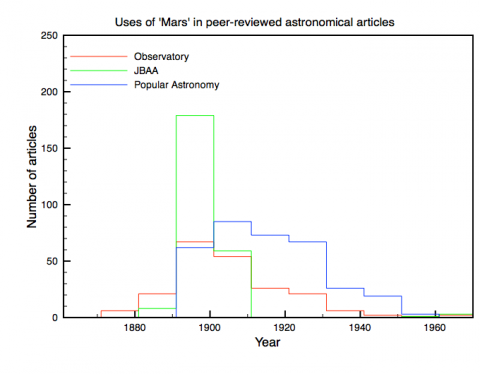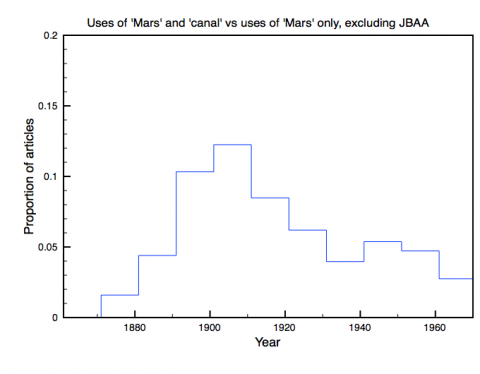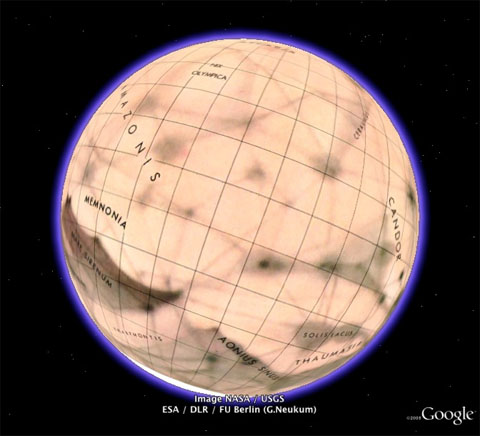In my post about the lingering scientific interest in the Martian canals hypothesis after 1909, I said that there was a problem with journal coverage. What do I mean by this? Have a look:
This is a repeat of the first plot in the previous post, showing the number of articles published in peer-reviewed astronomical journals mentioning ‘Mars’ and ‘canals’ between 1861 and 1970, only this time for each of three journals: Observatory, Journal of the British Astronomical Association, and Popular Astronomy. I chose these three because they were the journals which had the most such articles, both over the entire period and in the peak decade of the 1890s.

And here’s the proportion of articles mentioning ‘Mars’ and ‘canals’ to articles just about ‘Mars’ alone for the same three journals. (After the 1940s, the small absolute numbers involved make these ratios essentially meaningless.)
When the data is examined in this way the narrative changes somewhat; but that’s only part of the problem. The pattern exhibited by Observatory in absolute terms actually matches the overall one pretty closely: a big jump in interest in the 1890s, a small decline in the 1900s, a much sharper decline thereafter but still with significant interest in the 1910s and 1920s. Popular Astronomy, however, is quite different. Not only did it actually publish more articles on ‘Mars’ and ‘canals’ in the 1900s than the 1890s, the peak decade overall, but the same is true of the 1910s and 1920s. Only from the 1930s is there a sharp drop, though the numbers of articles is still significant. This sustained level of interest is quite surprising, and suggests that Popular Astronomy was the house journal of the Martian canalists, so to speak. Relative to the total number of articles on ‘Mars’, both journals published about the same proportion on ‘Mars’ and ‘canals’; Observatory actually published a higher proportion in the 1910s than the 1900s, out of a lower overall number of course.
The real problem, however, is JBAA. It didn’t start publishing until 1890, but that’s okay. It has the usual big peak in the 1890s and a sharp drop in the following decade, though still to a relatively high level. But the thing is that Fulltext Service’s coverage for JBAA has some big gaps: there is nothing between 1906 and 1951 inclusive, for example, and it’s quite patchy thereafter. So half the decade 1901 to 1910 is missing. If it published articles on the Martian canals at the same rate between 1906-10 as between 1901-5 then the total for the decade would double, from about 80% of the 1890s peak rather than 40%. Moreover, with no data for the 1910s and 1920s we can’t tell how interested JBAA was in the Martian canals debate in these interesting decades.
This wouldn’t matter so much except that, even with this reduced coverage, JBAA was far and away the most prolific publisher of articles mentioning ‘Mars’ and ‘canals’ in the 1890s, more than Observatory and Popular Astronomy put together. In fact, it published fully 40% of all such articles in the Fulltext Service. That’s a huge proportion, and it means that this one journal could skew the results significantly. And that’s especially problematic given the gaps in the coverage. It could be that JBAA sustained or even increased its interest in Martian canals in the 1910s and 1920s. Certainly the missing data after 1905 serves to exaggerate the 1890s peak. But it also could be that JBAA‘s trends aren’t reflective of the astronomical community as a whole.
So I think it’s better to leave out JBAA altogether. The ADS Fulltext Service doesn’t allow you to do this easily, but I can just subtract the JBAA numbers from the overall ones. Here is the absolute number of articles mentioning ‘Mars’ and ‘canals’:
And here is the number relative to the total number mentioning ‘Mars’ alone:
Compared with the versions in the previous post, these now more or less resemble each other. Also, as I predicted, the 1890s peak has come right down relative to the 1900s, though it’s a surprise to note that the 1900s is actually a little higher. In terms of the post-1909 trends, in absolute terms the 1910s and 1920s were a step down from the 1900s, in relative terms it looks like a steady decline until the 1940s. So, on this evidence the 1890s and 1900s were the peak period for the Martian canals hypothesis as far as astronomers were concerned, which fits in with the ‘Antoniadian resolution’ in 1909; but there was still strong if declining interest in the 1910s and 1920s, and this interest should not be dismissed out of hand.
One loose end I should have mentioned before now: I don’t think these three journals were among the top tier of astronomical journals, which would include titles such as Astronomical Journal, Monthly Notices of the Royal Astronomical Society and Publications of the Astronomical Society of the Pacific. It’s also noticeable that they are not necessarily aimed at or written by professional astronomers. As its name suggests, Popular Astronomy (an American journal which ceased publication in 1951) was for a relatively popular audience, though its articles were at least semi-technical in nature and apparently peer-reviewed. As for JBAA, the British Astronomical Association was and is the major organisation for amateur astronomers in Britain. While Observatory is loosely associated with the professional equivalent, the Royal Astronomical Society and is peer-reviewed, it’s noticeably less serious than your average astronomical journal (one article published last year is entitled ‘The Astronomer Royal’s XI versus The World, 1971’). Now, astronomy is an unusual science in that amateurs can and do undertake serious research, particularly in areas like variable stars where professionals lack the resources to watch everything worth watching. So it would be wrong to think of these journals as necessarily lower-quality than the professional ones. But it does seem significant that the more ‘popular’ astronomical journals had the greatest interest in the Martian canals. And it may well be that the patterns I’ve discerned here don’t hold for the professional journals. In fact… I think I will have to do another post to check that. And then I will get back to aeroplanes, I promise!
![]() This work is licensed under a Creative Commons Attribution-NonCommercial-NoDerivatives 4.0 International License.
Permissions beyond the scope of this license may be available at http://airminded.org/copyright/.
This work is licensed under a Creative Commons Attribution-NonCommercial-NoDerivatives 4.0 International License.
Permissions beyond the scope of this license may be available at http://airminded.org/copyright/.








